I haven't provided detailed commentary on the US labour market for a while now. To…
US labour market continues to improve but a jobs deficit remains
On May 5, 2017, the US Bureau of Labor Statistics (BLS) released their latest labour market data – Employment Situation Summary – April 2017 – which showed that total non-farm employment from the payroll survey rose by 211,00 in April up from the miserable 98,000 the previous month. The unemployment rate fell from 4.5 per cent to 4.4 per cent. The estimate of employment change from the Labour Force Survey was also positive (156 thousand net jobs added). Last month, we wondered whether the poor showing signalled the beginning of a slowdown after the positive ‘Trump’ spike or whether it was just a monthly variation that will iron itself out over the longer period. We are probability safer concluding it was monthly variation. Whatever the direction, there is still a large jobs deficit remaining and other indicators suggest the labour market is still below where it was prior to the crisis.
Overview
For those who are confused about the difference between the payroll (establishment) data and the household survey data you should read this blog – US labour market is in a deplorable state – where I explain the differences in detail.
See also the – Employment Situation FAQ – provided by the BLS, itself.
The BLS say that:
The establishment survey employment series has a smaller margin of error on the measurement of month-to-month change than the household survey because of its much larger sample size. … However, the household survey has a more expansive scope than the establishment survey because it includes self-employed workers whose businesses are unincorporated, unpaid family workers, agricultural workers, and private household workers …
Focusing on the Household Labour Force Survey data, the seasonally adjusted labour force rose by only 12 thousand in April 2017 as the participation rate fell by 0.1 points to 62.9 per cent.
The decline in the participation rate is a reversal on the positive increases earlier in the year but it is still higher than the level in November 2016 of 62.6 per cent, which is usually a sign that employment opportunities are becoming easier to access.
Total employment rose by 156 thousand in net terms, and as a consequence, official unemployment fell by 146 thousand.
The unemployment rate eased from 4.5 per cent to 4.4 per cent.
The continued positive state of the US labour market has to be seen in the context, however, of the fact that the US economy has been undermining standard wage employment since 2005 (see – All net jobs in US since 2005 have been non-standard) and has demonstrated a bias towards low-wage job creation (see below for updated analysis).
Further, the April 2017 participation rate of 62.9 per cent is still far below the peak in December 2006 (66.4).
Adjusting for the ageing effect (see US labour market – some improvement but still soft for an explanation of this effect), the rise in those who have given up looking for work (discouraged) since December 2006 is around 3.7 million.
If we added them back into the labour force and considered them to be unemployed (which is not an unreasonable assumption given that the difference between being classified as officially unemployed against not in the labour force is solely due to whether the person had actively searched for work in the previous month) – we would find that the current US unemployment rate would be around 6.8 per cent rather than the official estimate of 4.7 per cent.
That provides a quite different perspective in the way we assess the US recovery.
The US labour market is still a long way from where it was at the end of 2007.
Payroll employment trends
The first graph shows the monthly change in payroll employment (in thousands, expressed as a 3-month moving average to take out the monthly noise).
The monthly changes were stronger in 2015, and then dipped in the first-half of 2016. By the end of 2016, job creation was stronger but then it tailed off again, somewhat.
In the first two months of 2017 (January and February), there was a strengthening of the net payroll employment change and the April 2017 result is consistent with that notwithstanding the poor result in March.
The next graph shows the same data in a different way – in this case the graph shows the average net monthly change in payroll employment (actual) for the calendar years from 2005 to 2017. Clearly, the average for 2017 is for January to April only.
The slowdown that began in 2014 has seemingly stabilised.
The average change so far in 2017 (185 thousand) is similar to the 187 thousand average for the whole of 2016.
The average net change in 2014 was 250 thousand, in 2015 it was 226 thousand.
Labour Force Survey – employment growth falling back slightly
In April 2017, employment increased by 0.10 per cent compared to the 0.01 per cent rise in the labour force. That is why the unemployment level fell by 146 thousand.
The next graph shows the monthly employment growth since the low-point unemployment rate month (December 2006). The red line is the average labour force growth over the period December 2001 to December 2006 (0.0910 per cent per month).
Employment growth in April 2017 was almost equal to the average labour force growth rate between 2001 and 2006.
What is apparent is that a strong positive and reinforcing trend in employment growth has not yet been established in the US labour market since the recovery began back in 2009. There are still many months where employment growth, while positive, remains relatively weak when compared to the average labour force growth prior to the crisis.
A good measure of the strength of the labour market is the Employment-Population ratio given that the movements are relatively unambiguous because the denominator population is not particularly sensitive to the cycle (unlike the labour force).
The following graph shows the US Employment-Population from January 1970 to April 2017. While the ratio fluctuates a little, the April 2017 outcome (60.2 per cent) was up by 0.5 points on December.
But it remains well down on pre-GFC levels (peak 63.4 per cent in December 2006), which is a further indication of how weak the recovery has been so far.
Federal Reserve Bank Labor Market Conditions Index (LMCI)
The Federal Reserve Bank of America has been publishing a new indicator – Labor Market Conditions Index (LMCI) – which is derived from a statistical analysis of 19 individual labour market measures since October 2014.
It is now being watched by those who want to be the first to predict a rise in US official interest rates. Suffice to say that the short-run (monthly) changes in the LMCI are “assumed to summarize overall labor market conditions”.
A rising value (positive change) is a sign of an improving labour market, whereas a declining value (negative change) indicates the opposite.
You can get the full dataset HERE.
I discussed the derivation and interpretation of the LMCI in this blog – US labour market weakening.
At the time of writing, the latest data available does not include the April 2017 observation. I will update when the dataset is updated by the central bank.
In March 2017, the LMCI rose by 0.4 index points down from 1.5 and continues the relative weak trend downwards since 2015.
The following graph shows the FRB LMCI for the period January 2007 to January 2017. At the time of writing, the February data had not yet been released.
We note that while unemployment is now lower than last year and the rate of hiring has stabilised after declining earlier in the year. The way these factors combine in the index leads to an overall assessment that the labour market has been in decline.
The fall away over the last nine months has been quite significant notwithstanding the July 2016 upturn. The index remains positive though.
The US jobs deficit
As noted in the Overview, the current participation rate (62.9 per cent) is a long way below the most recent peak in December 2006 of 66.4 per cent.
When times are bad, many workers opt to stop searching for work while there are not enough jobs to go around. As a result, national statistics offices classify these workers as not being in the labour force (they fail the activity test), which has the effect of attenuating the rise in official estimates of unemployment and unemployment rates.
These discouraged workers are considered to be in hidden unemployment and like the officially unemployed workers are available to work immediately and would take a job if one was offered.
But the participation rates are also influenced by compositional shifts (changing shares) of the different demographic age groups in the working age population. In most nations, the population is shifting towards older workers who have lower participation rates.
Thus some of the decline in the total participation rate could simply being an averaging issue – more workers are the average who have a lower participation rate.
I analysed this declining trend in this blog – Decomposing the decline in the US participation rate for ageing.
I updated that analysis to December 2015 and computed that the decline in the participation rate due to the shift in the age composition of the working age population towards older workers with lower participation rates accounted for about 58 per cent of the actual decline.
Thus, even if we take out the estimated demographic effect (the trend), we are still left with a massive cyclical response.
What does that mean for the underlying unemployment?
The labour force changes as the underlying working age population grows and with changes in the participation rate.
If we adjust for the ageing component of the declining participation rate and calculate what the labour force would have been given the underlying growth in the working age population if participation rates had not declined since December 2006 then we can estimate the change in hidden unemployment since that time due to the sluggish state of the US labour market.
Adjusting for the demographic effect would give an estimate of the participation rate in April 2017 of 64.4 if there had been no cyclical effects (1.5 percentage points up from the current 62.9 per cent).
So the 1.5 percentage point decline in the participation rate due to the downturn (net of ageing effect) amounts to 3,820 thousand workers who have left the labour force as a result of the cyclical sensitivity of the labour force.
It is hard to claim that these withdrawals reflect structural changes (for example, a change in preference with respect to retirement age, a sudden increase in the desire to engage in full-time education).
We can have a separate debate about whether 4.4 per cent constitutes full employment in the US. My bet is that if the government offered an unconditional Job Guarantee at an acceptable minimum wage there would be a sudden reduction in the national unemployment rate which would take it to well below 4.4 per cent without any significant inflationary impacts (via aggregate demand effects).
So I doubt 4.4 per cent is the true irreducible minimum unemployment rate that can be sustained in the US.
But we will use it as a benchmark so as not to get sidetracked into definitions of full employment. In that sense, my estimates should be considered the best-case scenario given that I actually think the cyclical losses are much worse than I provide here.
For those mystified by this statement – it just means that I think the economy was not at full employment in December 2006 and thus was already enduring some cyclical unemployment at that time.
Using the estimated potential labour force (controlling for declining participation), we can compute a ‘necessary’ employment series which is defined as the level of employment that would ensure on 4.4 per cent of the simulated labour force remained unemployed.
This time series tells us by how much employment has to grow each month (in thousands) to match the underlying growth in the working age population with participation rates constant at their January 2007 peak – that is, to maintain the 4.4 per cent unemployment rate benchmark.
I computed the ‘necessary’ employment series based on the age-adjusted potential labour force (dark green line in the following graph).
The light blue line is the actual employment as measured by the BLS and the dotted red line is the level of employment that prevailed in November 2007 (the peak before the crisis).
This allows us to calculate how far below the 4.4 per cent unemployment rate (constant participation rate) the US employment level currently is.
There are two effects:
- The actual loss of jobs between the employment peak in November 2007 and the trough (January 2010) was 8,582 thousand jobs. However, total employment is now above the January 2008 peak by 6,561 thousand jobs. This gain in jobs is measured by the AB gap in the graph which shows the gap in employment relative to the November 2007 peak (the dotted red line is an extrapolation of the peak employment level). You can see that it wasn’t until July 2014 that the US labour market reached the November 2007 peak employment level again.
- The shortfall of jobs (the overall jobs gap) is the actual employment relative to the jobs that would have been generated had the demand-side of the labour market kept pace with the underlying population growth (Required Employment Adjusted for Ageing) – that is, with the participation rate at its December 2006 peak and the unemployment rate constant at 4.4 per cent. This shortfall (BC) loss amounts to 3,660 thousand jobs. This is the segment BC measured as at April 2017.
The next graph shows the difference between the blue and green lines in the above graph. The US Jobs Gap is thus the departure of current employment from the level of employment that would have generated a 4.4 per cent unemployment rate, given current population trends.
While the jobs gap is declining, it is still substantial.
To put that into further perspective, the following graph shows the BLS measure U6, which is defined as:
Total unemployed, plus all marginally attached workers plus total employed part time for economic reasons, as a percent of all civilian labor force plus all marginally attached workers.
It is thus the broadest measure of labour underutilisation that the BLS publish.
In December 2006, before the affects of the slowdown started to impact upon the labour market, the measure was estimated to be 7.9 per cent. It now stands at 8.6 per cent (April 2017) which means it has fallen by 0.6 points since the end of 2016, another reason why I am thinking this month represents improvement.
The U-6 measure fell by 0.3 points in April 2017 matching the decline in March 2017.
While showing improvement, the U-6 measure remains well above previous troughs, which suggests (along with the other signals presented above) that the labour market is still some way from being considered ‘recovered’.
It means that while unemployment has declined modestly over the last year, underemployment and hidden unemployment have risen.
Gross Flows and Transition Probabilities
Instead of just looking at the raw employment and unemployment data, I find that I get a lot more intelligence of the dynamics of the labour market by examining the gross flows data.
I updated that dataset for the US today (which takes us to April 2017) and computed updated Transition Probabilities, which are derived from the Gross Flows labour market data.
To fully understand the way gross flows are assembled and the transition probabilities calculated you might like to read these blogs – What can the gross flows tell us? and More calls for job creation – but then. For earlier US analysis see this blog – Jobs are needed in the US but that would require leadership
The data is available from the – US Bureau of Labor Statistics.
Gross flows analysis allows us to trace flows of workers between different labour market states (employment; unemployment; and non-participation) between months. So we can see the size of the flows in and out of the labour force more easily and into the respective labour force states (employment and unemployment).
Each period there are a large number of workers that flow between the labour market states – employment (E), unemployment (U) and not in the labour force (N). The stock measure of each state indicates the level at some point in time, while the flows measure the transitions between the states over two periods (for example, between two months).
The net changes each month – between the stock measures – are small relative to the absolute flows into and out of the labour market states.
National statisticians measure these flows in their monthly labour force surveys. The various stocks and flows are denoted as follows (single letters denote stocks, dual letters are flows between the stocks):
- E = employment stock, with subscript t = now, t+1 the next period.
- U = unemployment stock.
- N = not in the labour force stock.
- EE = flow from employment to employment (that is, the number of people who were employed last period who remain employment this period)
- UU = flow of unemployment to unemployment (that is, the number of people who were unemployed last period who remain unemployed this period)
- NN = flow of those not in the labour force last period who remain in that state this period
- EU = flow from employment to unemployment
- EN = flow from employment to not in the labour force
- UE = flow from unemployment to employment
- UN = flow from unemployment to not in the labour force
- NE = flow from not in the labour force to employment
- NU = flow from not in the labour force to unemployment
The following Matrix Table provides a schematic description of the flows that can occur between the three labour force framework states.
The various inflows and outflows between the labour force categories are expressed in terms of numbers of persons which can then be converted into so-called transition probabilities – the probabilities that transitions (changes of state) occur.
We can then answer questions like: What is the probability that a person who is unemployed now will enter employment next period?
So if a transition probability for the shift between employment to unemployment is 0.05, we say that a worker who is currently employed has a 5 per cent chance of becoming unemployed in the next month. If this probability fell to 0.01 then we would say that the labour market is improving (only a 1 per cent chance of making this transition).
From the table above – sometimes called a Gross Flows Matrix – the element EE tells you how many people who were in employment in the previous month remain in employment in the current month.
Similarly the element EU tells you how many people who were in employment in the previous month are now unemployed in the current month. And so on. This allows you to trace all inflows and outflows from a given state during the month in question.
The transition probabilities are computed by dividing the flow element in the matrix by the initial state. For example, if you want the probability of a worker remaining unemployed between the two months you would divide the flow (UU) by the initial stock of unemployment. If you wanted to compute the probability that a worker would make the transition from employment to unemployment you would divide the flow (EU) by the initial stock of employment. And so on.
So the 3 Labour Force states in the Matrix Table above allow us to compute 9 transition probabilities reflecting the inflows and outflows from each of the combinations.
Analysing movements in these probabilities over time provides a different insight into how the labour market is performing by way of flows of workers.
The first graph shows the transition probabilities between employment and unemployment from December 2007 to April 2017.
The probability crossed twice over this period – early on in the GFC when employment was collapsing and unemployment was rising quickly (September 2008) and, more recently, around mid-2014.
Since then there has been a steady fall in the chance of an employed worker losing their job, while the chance of an unemployed worker gaining employment has continued to rise.
That is no evidence there that the US labour market is weakening.
However, it should be noted that the UE probability in April 2017 (26.7 per cent) is still well below the pre-GFC levels (not shown) where in December 2006 it was 30.2 per cent. To put that further in historical context, the UE probability at the turn of the century was 35.5 per cent.
So while the US labour market has improved from its state between 2008 and 2014, the chances of an worker gaining employment again if they become unemployed is much lower now than it was 10 years or so ago and much lower than 17 years ago.
The next graph compares the UE and the UN (probability that an unemployed worker will exit the labour force) from January 1990 to April 2017.
This is very interesting graph.
When workers are confronted with a lack of employment opportunities they often exit the labour force (give up looking for work) and enter what we call hidden unemployment.
Comparing UE and UN probabilities helps us see these dynamics.
The graph shows that prior to the GFC, the UN transition probability was always below the UE probability. So unemployed workers were always more likely to get a job than leave the labour force.
That changed with the GFC when the job opportunities dried up.
The switch point came in early 2016 (when UE > UN) but in April 2017, the likelihood of an unemployed worker gaining a job was 26.7 per cent whereas the likelihood of an unemployed person leaving the labour force was 23.7 per cent. Not a lot of difference.
This reinforces the assessment that while the US labour market has improved it is still a long way from where it was before the crisis began.
The next graph compares the US transition probabilities for selected months during the crisis (including the trough after the GFC – October 2008) up until April 2017 (see the accompanying Table for values).
December 2007 was the peak of the last cycle and things deteriorated after that. The graph and table give you a good summary of how things have changed in the 9.5 years of recession and recovery in the individual probabilities.
The probability of an unemployed person getting a job (UE) has not changed much since late 2015 after plunging in the downturn.
The overall impression is that those in employment are becoming more slightly secure (static EU probability and rising EE probability) but that the flows between the states are becoming less dynamic.
To provide a time series view of the crisis and its aftermath, the next graph (or 6 separate graphs) shows the the US transition probabilities from December 2007 (the low-point unemployment rate month of the last cycle) to April 2017 for the 6 transitions (EU, UE, EN, NE, NU, and UN). We exclude the same state probabilities (EE, UU, and NN). Note the vertical scales are different (they are optimised for the particular range of probabilities in each.
Several points by way of interpretation can be made (noting that care should be taken to recognise the vertical scales are quite different).
First, the EU probability (employment to unemployment) has fallen since the early days of the crisis but is now hovering around 11 per cent.
Second, the EN probability rose during the crisis and again during the recovery, the latter shift, indicating that employed workers were increasingly likely to flow out of the labour force once they lose their jobs – that is, they become hidden unemployed or retire (in some form or another).
Third, the likelihood of a new entrant getting a job (NE prob) has fallen in recent months. However, it remains that new entrants are much more likely to become employed (NE prob) than to enter the labour force as unemployed (NU).
Conclusion
The evidence is fairly consistent across a range of measures – the mass unemployment in the US was the result of a systemic failure in that economy to produce enough jobs, which emerged as aggregate spending collapsed in early 2008.
Since then, as the economy has slowly starting growing again, the demand-side of the labour market has improved steadily and the unemployment rate has fallen.
While the March 2017 result sent a mixed signal, the April 2017 employment growth was consistent with the more positive results observed in January and February.
Employment growth remains consistent with the average monthly change observed throughout 2016.
There is still a significant jobs shortfall relative to the pre-GFC position, even though the unemployment rate is now around 4.4 per cent which brings into question the claims that the US labour market is at full employment.
The reason for this skepticism is that the participation rate is still well below where it was even after we adjust for the ageing effects (retirements).
That is enough for today!
(c) Copyright 2017 William Mitchell. All Rights Reserved.
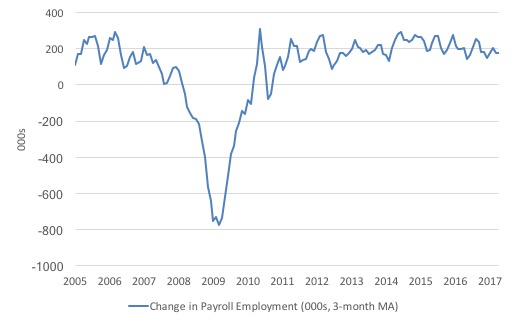
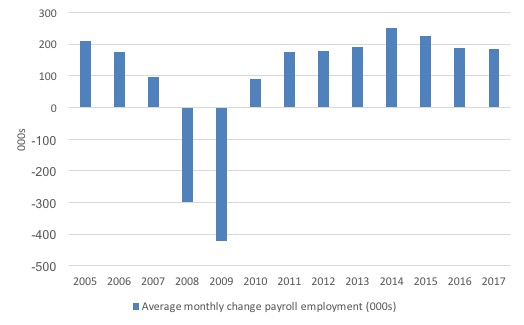
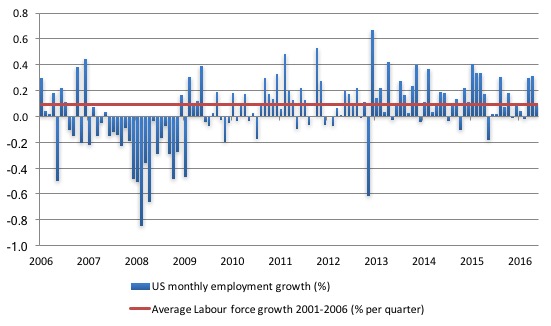
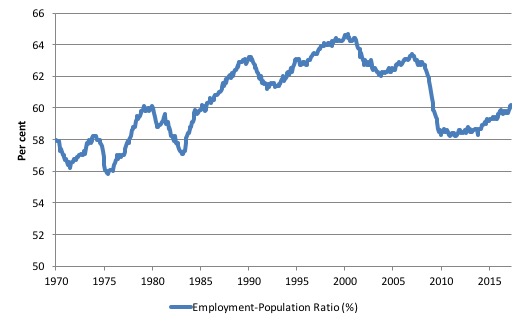
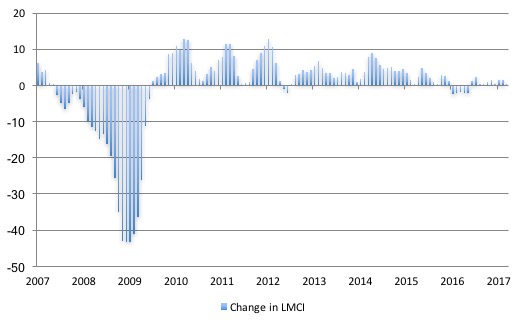
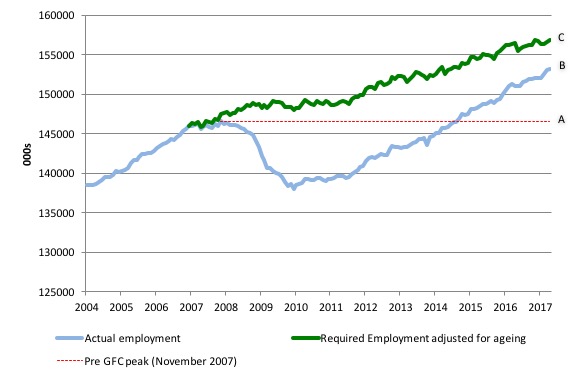
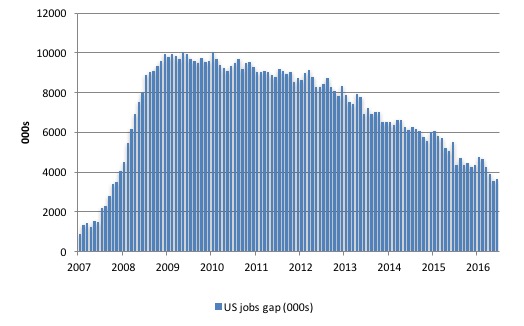
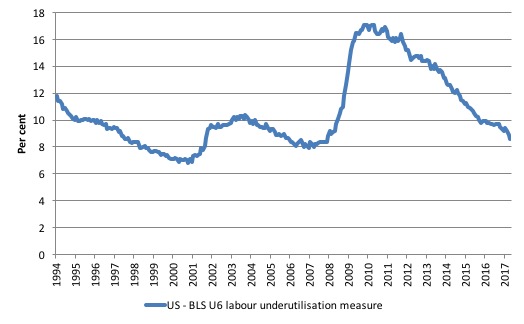

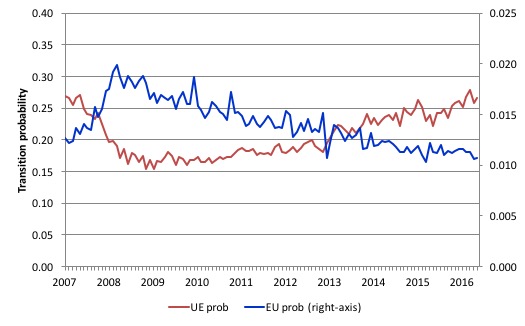
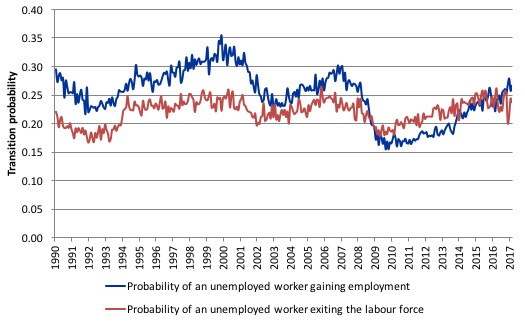
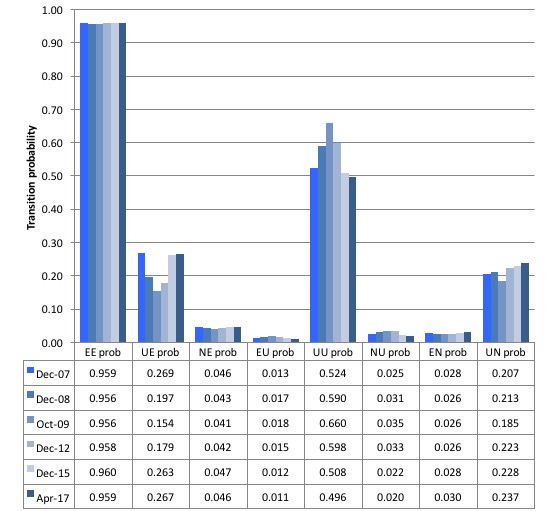
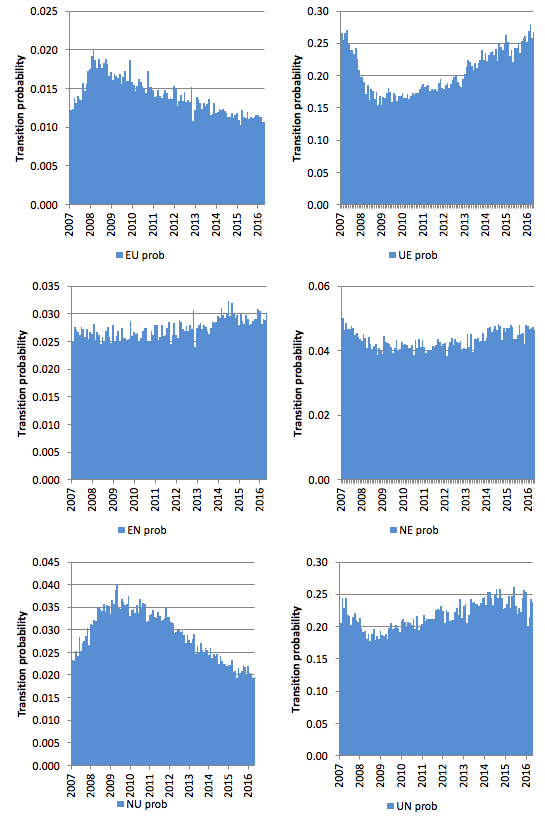
Surely you mean 1.1 per cent?
Bill,
Major US retailers are closing over 3000 stores so far this year and some seeking legal protection from bankruptcy -shopping malls not what they were!
Regards
Further evidence that the necessary policy prescription is a Full Employment Fiscal Policy coupled with a Job Guaranty